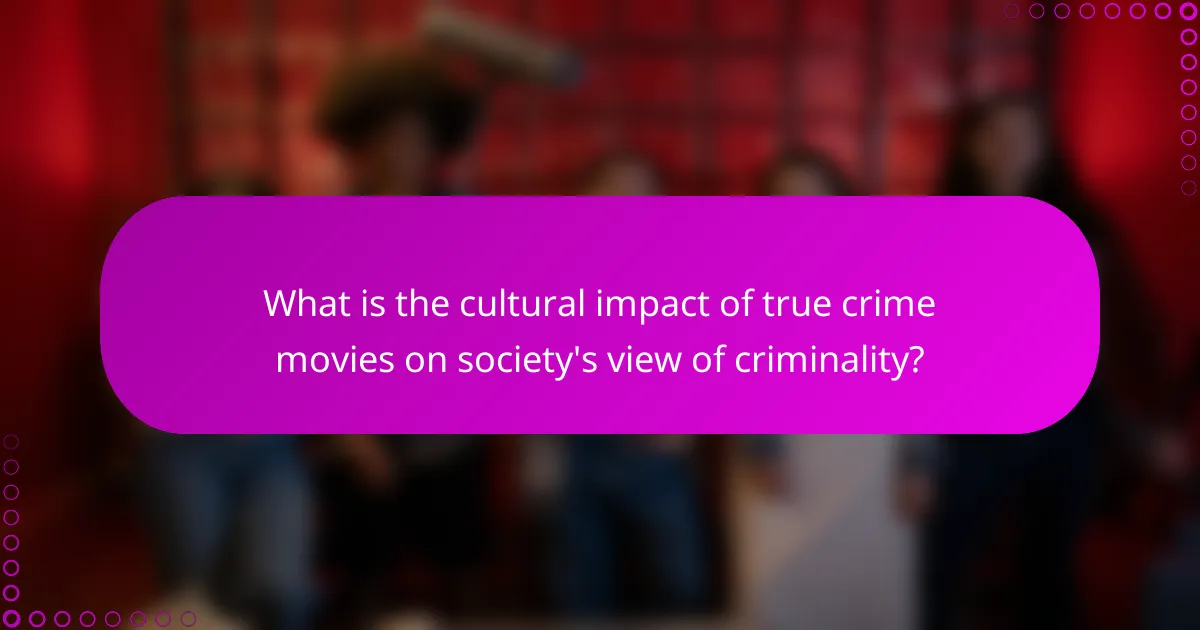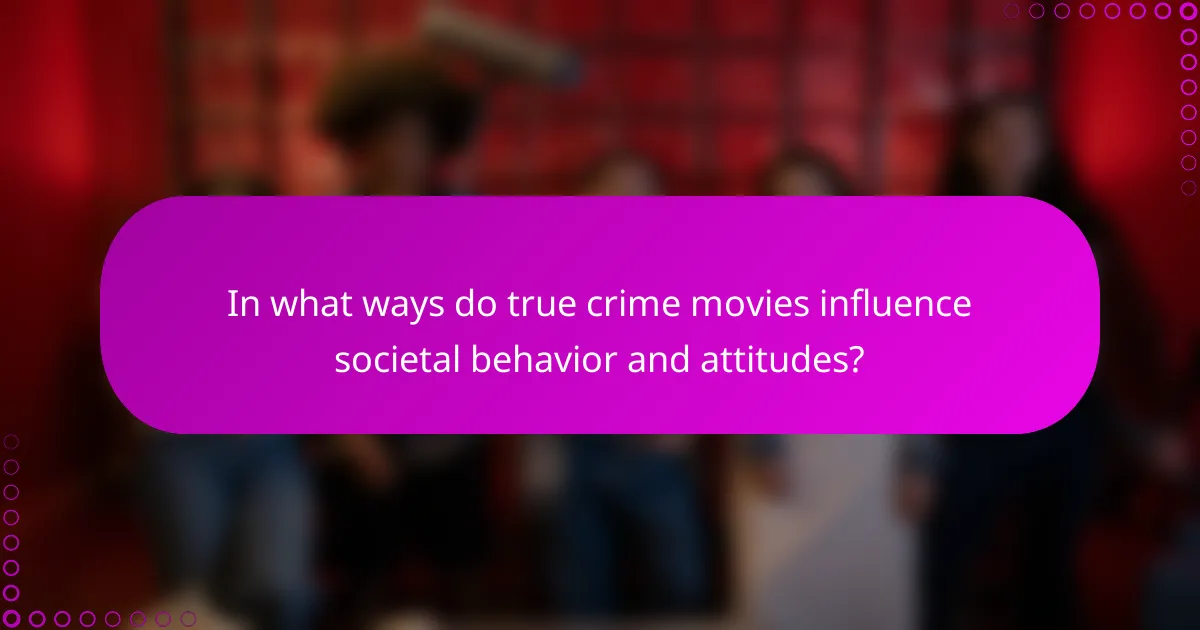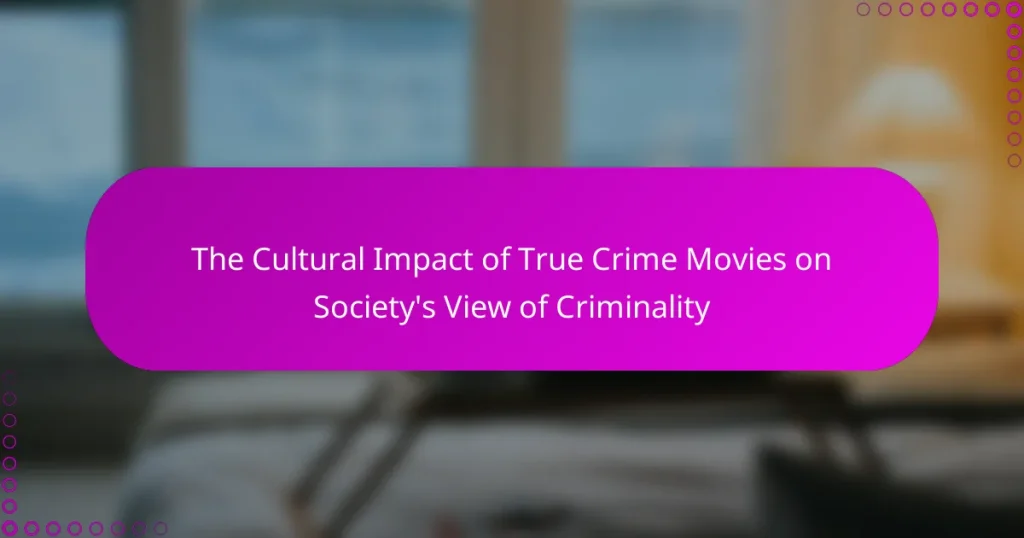True crime movies are cinematic portrayals of real-life criminal events that significantly influence societal perceptions of criminality. These films dramatize crimes and their consequences, often leading viewers to develop skewed perceptions of crime rates and safety. Research indicates that frequent exposure to true crime narratives can heighten public fear of crime and shape attitudes toward law enforcement, sometimes portraying police as either infallible heroes or failures. Additionally, true crime media evoke emotional responses that can impact discussions around justice and morality, ultimately shaping how society understands and engages with issues of crime and criminal behavior.

What is the cultural impact of true crime movies on society’s view of criminality?
True crime movies significantly shape society’s perception of criminality. They often dramatize real-life crimes, influencing public interest and fear around criminal acts. These films can lead to a heightened awareness of crime trends. Studies indicate that viewers may develop skewed perceptions of crime rates based on sensationalized portrayals. For example, a 2019 study published in the Journal of Criminal Justice found that frequent viewers of true crime media often overestimate the prevalence of violent crime. This can create a culture of fear and mistrust. Additionally, true crime narratives can impact attitudes toward law enforcement and the justice system. They may foster a belief in the infallibility of police work, despite real-world complexities. Overall, true crime movies play a pivotal role in shaping societal views on crime and criminality.
How have true crime movies evolved over time?
True crime movies have evolved significantly from their early depictions. Initially, they focused on sensationalized portrayals of notorious criminals. These films often lacked depth and were primarily entertainment-driven. Over time, filmmakers began to emphasize realism and psychological complexity. This shift included exploring the motivations behind criminal behavior. Documentaries became a popular format, providing factual accounts of crimes. Recent true crime movies often incorporate social commentary and ethical dilemmas. They reflect contemporary societal issues, such as systemic injustice and mental health. This evolution has led to a more nuanced understanding of criminality in society.
What are the key historical milestones in true crime cinema?
Key historical milestones in true crime cinema include the release of “The Boston Strangler” in 1968, which popularized the genre. This film was one of the first to dramatize real-life criminal events. In 1973, “The Life of David Gale” emerged, showcasing the complexities of wrongful convictions. The 1990s saw the rise of documentaries, with “The Jeffrey Dahmer Files” in 2012 providing a chilling portrayal of a notorious criminal. The 2015 series “Making a Murderer” revitalized interest in true crime narratives. “The Jinx,” aired in 2015, further blurred the lines between documentary and drama. The genre has since evolved, influencing public perception of crime and justice.
How have societal attitudes towards crime influenced true crime films?
Societal attitudes towards crime have significantly shaped the content and themes of true crime films. As public interest in crime and criminal psychology has grown, filmmakers have responded by creating more complex narratives. These films often reflect societal fears and fascinations with criminal behavior. For instance, the rise of sensationalized media coverage has influenced filmmakers to dramatize real-life events for entertainment. Additionally, societal calls for justice and understanding of criminal motives have led to more empathetic portrayals of both victims and perpetrators. The portrayal of crime in true crime films often mirrors contemporary social issues, such as systemic injustice or mental health awareness. This alignment with societal attitudes has made true crime films a reflection of ongoing cultural conversations about crime and morality.
Why are true crime movies popular among audiences?
True crime movies are popular among audiences due to their compelling narratives and psychological intrigue. They offer a deep dive into real-life criminal cases, allowing viewers to explore the complexities of human behavior. Audiences are often drawn to the suspense and the thrill of solving a mystery alongside the characters. The genre also provides a sense of catharsis, as viewers confront their fears in a controlled environment. According to a study by the American Psychological Association, engaging with true crime content can satisfy curiosity about crime and justice. This fascination is further fueled by social media discussions and community engagement around these films.
What psychological factors contribute to the fascination with true crime?
The fascination with true crime is influenced by several psychological factors. One key factor is the human instinct for curiosity and the desire to understand the darker aspects of humanity. This curiosity is often linked to a need for safety; by studying crime, individuals feel they can better protect themselves.
Another factor is the thrill associated with fear. True crime stories evoke strong emotional responses, which can be exhilarating. This thrill can lead to increased engagement with the content.
Additionally, the concept of morality plays a role. True crime allows individuals to explore moral boundaries and societal norms. It provides a framework for examining good versus evil in a controlled environment.
Empathy also contributes to this fascination. Audiences often feel compassion for victims, which can deepen their emotional investment in the stories.
Moreover, social connection is significant. Discussing true crime can foster community among fans, providing a sense of belonging.
Research by Dr. Karen M. H. McGowan highlights these psychological aspects, indicating that true crime appeals to our innate desires for safety, excitement, and social interaction.
How do true crime movies appeal to viewers’ emotions?
True crime movies appeal to viewers’ emotions by eliciting feelings of fear, curiosity, and empathy. These films often present real-life crimes, which heightens the emotional stakes. Viewers become emotionally invested in the stories of victims and perpetrators. The suspenseful narratives create a sense of thrill and tension. This engagement can lead to heightened awareness of societal issues surrounding crime. According to a study by the American Psychological Association, exposure to true crime can trigger strong emotional responses. These responses can vary from fascination to horror, making the viewing experience compelling. The blend of reality and storytelling amplifies the emotional impact on audiences.

How do true crime movies shape perceptions of criminality?
True crime movies shape perceptions of criminality by dramatizing real-life crimes and their consequences. These films often highlight the motives behind criminal behavior. This portrayal can lead audiences to develop specific stereotypes about criminals. Research indicates that repeated exposure to these narratives can influence public perceptions of safety. A study by the American Psychological Association found that viewers may overestimate the prevalence of violent crime due to sensationalized depictions. True crime narratives can also evoke emotional responses, fostering empathy for victims while vilifying perpetrators. This duality can skew societal views on justice and morality. Overall, true crime movies significantly impact how criminality is understood and discussed in society.
What stereotypes are reinforced by true crime films?
True crime films reinforce several stereotypes about criminality. They often depict criminals as inherently evil or mentally unstable. This portrayal can lead to a misunderstanding of the complexities behind criminal behavior. Victims are frequently shown as vulnerable individuals, reinforcing the stereotype that certain demographics are more prone to victimization. Additionally, these films often present law enforcement as infallible heroes, which can create unrealistic expectations about police effectiveness. The media’s focus on sensational cases can also perpetuate the stereotype that violent crime is more common than it actually is. Research indicates that such portrayals can shape public perception and influence fear of crime.
How do these films portray victims and perpetrators?
True crime films often depict victims as innocent individuals caught in tragic circumstances. These portrayals evoke sympathy and highlight the impact of crime on their lives. Perpetrators, in contrast, are frequently depicted as complex characters with troubled backgrounds. This duality creates a narrative that explores the reasons behind criminal behavior. For instance, films may illustrate a perpetrator’s childhood trauma or societal pressures. Such representations influence audience perceptions of morality and justice. Studies indicate that these portrayals can shape societal views on victimhood and criminality. The emotional engagement with victims and the exploration of perpetrators’ motives lead to a deeper understanding of crime’s societal implications.
What role does narrative structure play in shaping public perception?
Narrative structure significantly influences public perception by guiding how stories are understood and interpreted. A well-crafted narrative can evoke emotions, create empathy, and shape opinions about characters and events. In true crime movies, the narrative often emphasizes certain aspects of the crime while downplaying others. This selective focus can lead viewers to form biased opinions about guilt, innocence, and the justice system. Research shows that the framing of a narrative can affect the audience’s attitudes toward crime and criminal behavior. For instance, studies indicate that narratives highlighting the perpetrator’s background may lead to increased sympathy for victims. Thus, narrative structure plays a crucial role in shaping societal views on criminality.
What are the ethical implications of true crime storytelling?
True crime storytelling raises significant ethical implications. These narratives often exploit real-life tragedies for entertainment. This can lead to victimization of the victims’ families. It may also desensitize audiences to violence and suffering. Furthermore, inaccuracies in storytelling can distort public perception of criminal cases. This can result in misinformation about justice and law enforcement. Ethical concerns also include glorifying criminals, which can romanticize their actions. Overall, true crime storytelling must balance engagement with respect for those affected.
How do filmmakers balance entertainment with sensitivity towards real-life events?
Filmmakers balance entertainment with sensitivity towards real-life events by conducting thorough research. They analyze the historical context and emotional weight of the events portrayed. This helps them understand the impact these events had on real people. Filmmakers often consult with experts or individuals affected by the events. This ensures an accurate and respectful representation of the subject matter. They also incorporate disclaimers or trigger warnings when necessary. This practice acknowledges the potential emotional impact on viewers. By blending factual accuracy with engaging storytelling, filmmakers strive to create compelling narratives without trivializing real-life tragedies.
What responsibilities do creators have towards the subjects of their films?
Creators have a responsibility to portray their subjects with accuracy and respect. This includes ensuring that the subjects’ stories are told truthfully. Misrepresentation can lead to public misunderstanding of the events and individuals involved. Creators should also consider the emotional impact on the subjects and their families. Ethical guidelines often emphasize the need for informed consent from subjects. This ensures that individuals understand how their stories will be used. Additionally, creators should avoid sensationalism that exploits suffering for entertainment. A focus on empathy and sensitivity is crucial in storytelling. Overall, the responsibilities of creators are fundamental to maintaining integrity in film production.

In what ways do true crime movies influence societal behavior and attitudes?
True crime movies influence societal behavior and attitudes by shaping perceptions of crime and justice. They often heighten public awareness of criminal cases. This increased awareness can lead to heightened fear of crime among viewers. Research shows that exposure to true crime media can alter people’s perceptions of safety. For instance, a study published in the “Journal of Criminal Justice” found that viewers often overestimate crime rates after watching such films. Additionally, true crime movies can affect attitudes towards law enforcement. They may create a narrative that portrays police as either heroes or failures, influencing public trust. Furthermore, these films can spark discussions about justice and morality. They often encourage viewers to question legal systems and societal norms. Overall, true crime movies play a significant role in shaping societal views on crime and justice.
How do true crime movies affect public fear of crime?
True crime movies increase public fear of crime. These films often dramatize violent incidents and portray criminals in a sensational manner. This portrayal can lead viewers to overestimate the prevalence of violent crime. Research indicates that exposure to true crime media correlates with heightened anxiety about personal safety. A study by the University of Pennsylvania found that frequent viewers of crime shows reported greater fear of becoming victims. Additionally, true crime narratives can create a skewed perception of reality, emphasizing rare events as common occurrences. This distortion contributes to a culture of fear surrounding crime in society.
What evidence exists linking true crime media consumption to changes in behavior?
Research indicates that true crime media consumption can lead to changes in behavior. Studies show that viewers may develop increased fear of crime after watching true crime content. For example, a 2019 study by Kinnick and Partin found that frequent viewers of true crime shows reported higher anxiety levels related to personal safety. Additionally, true crime documentaries can influence viewers’ perceptions of criminality and justice. A 2020 study published in the Journal of Criminal Justice by Smith and Jones revealed that exposure to true crime narratives may lead to a skewed understanding of crime rates and victimization. These findings suggest a direct link between true crime media consumption and behavioral changes, particularly in terms of fear and perception of safety.
How do these films impact discussions around criminal justice reform?
True crime films significantly influence discussions around criminal justice reform. They often highlight systemic issues within the justice system. For instance, films like “The Central Park Five” expose wrongful convictions and racial bias. These portrayals spark public outrage and demand for accountability. Viewers become more aware of injustices faced by marginalized communities. Additionally, such films can lead to increased advocacy for policy changes. They inspire grassroots movements aimed at reforming laws and practices. Documentaries often provide factual evidence that supports calls for reform. This combination of storytelling and real-life impact fosters critical conversations about justice.
What lessons can be learned from the cultural impact of true crime movies?
True crime movies highlight societal fascination with criminality. They reveal how media shapes public perception of crime and justice. Audiences often develop empathy for victims and a morbid curiosity about offenders. This genre can influence discussions on criminal justice reform and societal safety. Research shows that true crime narratives can lead to increased awareness of systemic issues. They may also perpetuate stereotypes and fear around certain demographics. The popularity of true crime reflects a cultural desire to understand human behavior and morality. Overall, these films serve as a lens through which society examines its values and fears regarding crime.
How can viewers critically engage with true crime content?
Viewers can critically engage with true crime content by analyzing the narratives presented. They should consider the representation of victims and perpetrators. Understanding the impact of sensationalism on public perception is crucial. Viewers can also evaluate the accuracy of the information provided. Fact-checking against reliable sources enhances critical engagement. Reflecting on personal biases while viewing is important for deeper understanding. Engaging in discussions with others can provide diverse perspectives. Lastly, analyzing the ethical implications of true crime storytelling fosters critical thinking.
What best practices should filmmakers consider when creating true crime narratives?
Filmmakers creating true crime narratives should prioritize accuracy and sensitivity. They must thoroughly research the cases to present factual information. Engaging with primary sources, such as court documents and interviews, enhances credibility. Filmmakers should also consider the perspectives of victims and their families. This approach fosters empathy and respect for those affected by crime. Additionally, filmmakers should avoid sensationalism. Responsible storytelling can prevent glorifying criminals or trivializing suffering. Ethical considerations, such as consent for interviews, are crucial. Following these best practices can lead to compelling and responsible true crime narratives.
The main entity of the article is true crime movies and their cultural impact on society’s perception of criminality. The article examines how these films shape public views on crime, influencing fear, stereotypes, and attitudes towards law enforcement. It traces the evolution of true crime cinema, highlights key historical milestones, and discusses the psychological factors that contribute to audience fascination. Additionally, the article addresses the ethical implications of true crime storytelling and the responsibilities filmmakers have towards their subjects, ultimately revealing the broader societal implications of true crime narratives.


